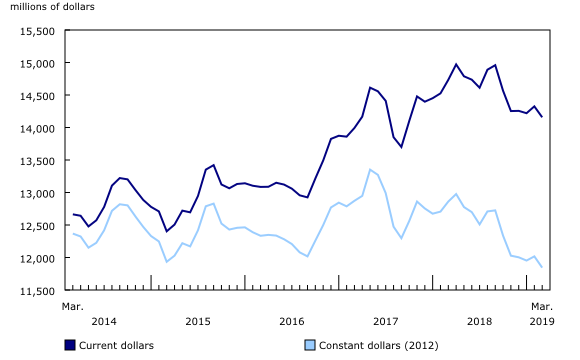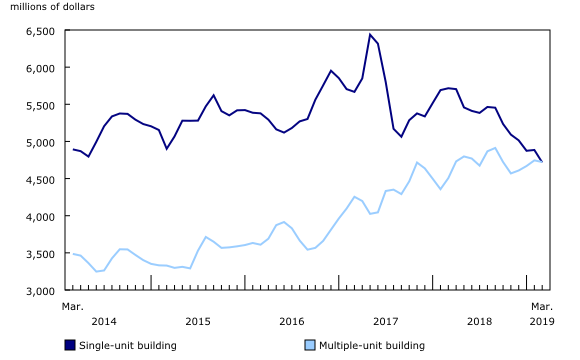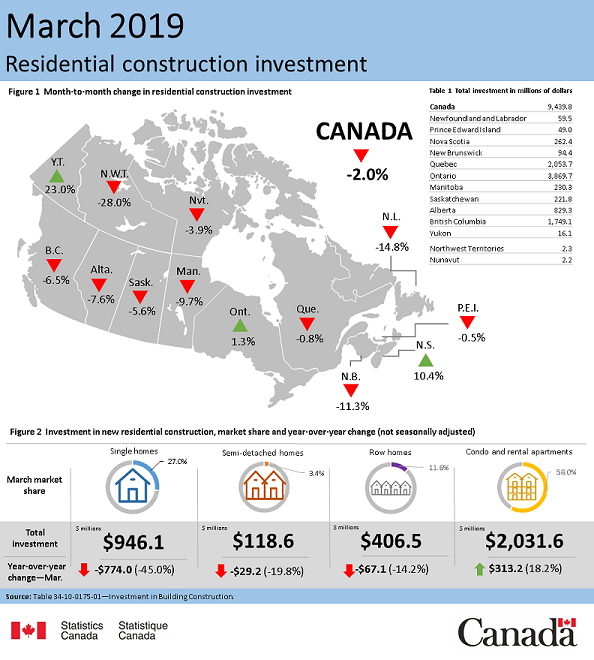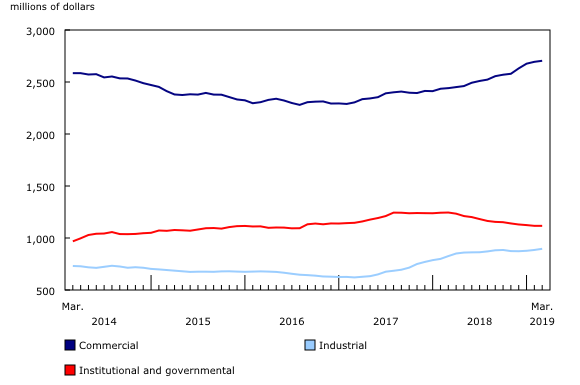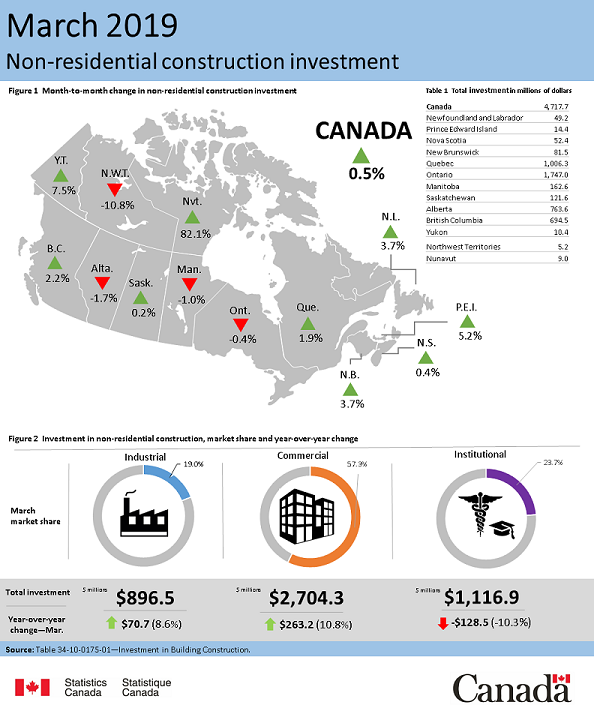Investment in building construction, March 2019
Archived Content
Information identified as archived is provided for reference, research or recordkeeping purposes. It is not subject to the Government of Canada Web Standards and has not been altered or updated since it was archived. Please "contact us" to request a format other than those available.
Released: 2019-05-21
$14.2 billion
March 2019
1.2% 
(monthly change)
Total investment in building construction decreased 1.2% in March to $14.2 billion. Losses in the residential sector (-2.0% to $9.4 billion) were partially offset by a small increase in the non-residential sector (+0.5% to $4.7 billion). On a constant dollar basis (2012=100), investment in building construction fell 1.4% to $11.8 billion.
Investment in multi-unit dwellings overtakes investment in singles
For the first time, investment in multi-unit dwelling construction exceeded that of singles, making it the largest component for investment in building construction. Although multi-unit investment exceeded single family investment, it remained well short of the record $6.4 billion set in May 2017. While both sectors declined in March, investment in single family homes (-3.4%) did so at a faster rate than investment in multi-unit dwellings (-0.5%).
Investment in commercial construction continues to climb
Within the non-residential sector, investment in commercial building construction marked its 14th consecutive monthly increase to reach a high of $2.7 billion. Gains for the month were concentrated in British Columbia, where the redevelopment of Vancouver's historic post office is well underway. The mixed use development will have two new office towers, which will be partially occupied by Amazon.
The industrial component rose 1.3% to $896 million in March on the strength of projects in Ontario and Quebec. Two projects that made notable contributions were the McNicoll Bus Garage in Scarborough and the new Radio Canada building in Montréal.
Following 11 consecutive monthly declines, institutional construction investment posted a small overall increase to settle at $1.1 billion. Notably, strength in Nunavut helped to moderate the decline as work on a new $40 million school in Kugaaruk continued.
First quarter 2019: Investment in new singles drops
Year over year for the first quarter, investment in new singles declined $2.1 billion (-29.8%) to $4.9 billion. This value represents an all-time low for the current series, which is available back to 2010. From a provincial perspective, nine provinces reported double-digit declines with the exception of Prince Edward Island (-6.3%). The provinces hit hardest were Ontario (-36.9%), Alberta (-38.1%) and British Columbia (-21.1%).
By contrast, investment in new apartments continued to increase, up 17.8% to $6.4 billion, with growth primarily concentrated in Central and Eastern Canada, as well as in British Columbia.
On an unadjusted basis, non-residential investment in new construction has been quite strong—increasing 8.1% year over year to $6.6 billion, on gains in the commercial (+$499 million) and industrial (+$201 million) components.
Note to readers
As per standard Statistics Canada practices, this release includes revised data for January 2015 through January 2019. In addition, data for January 2010 through December 2014 have been added to the current series.
Data presented in this release are seasonally adjusted and are expressed in current dollars unless otherwise stated. Using seasonally adjusted data facilitates month-to-month comparisons by removing the effects of seasonal variations. For information on seasonal adjustment, see Seasonally adjusted data – Frequently asked questions.
Monthly estimates for constant dollars are calculated using quarterly deflators from the Building Construction Price Index (18-10-0135-01). Typically, the first two months of a quarter use the previous quarters' price level and are revised when the new quarterly price index becomes available.
Detailed data on investment activity by type of building and type of work are now available in the unadjusted current dollar series.
As a result of data source constraints, the total value for "type of work – all" may not equal the sum of its parts (new construction, renovation, conversion, and other). The component required to complete the summation is "type of structure, minor."
In the type of work series "conversions total," one or more residential dwelling units are created from an existing structure. Deconversions, garages and carports, as well as in-ground swimming pools, are grouped together in the "other types of work" category.
Prior to January 2018, building permits for cottages with a value greater than $60,000 were automatically reclassified to structure type Single. Beginning with January 2018, regardless of value, building permits received from municipalities coded as cottages remain classified as a cottage.
Effective November 23, 2018, table 34-10-0175-01 contains data on both the residential and non-residential sector. It replaced tables 34-10-0010-01, 34-10-0011-01 and 34-10-0012-01.
Next release
Data on investment in building construction for April will be released on June 21.
Products
Statistics Canada has a new Housing Market Indicators Dashboard. This web application provides access to key housing market indicators for Canada, by province and by census metropolitan area. These indicators are automatically updated with new information from monthly releases, giving users access to the latest data.
Contact information
For more information, or to enquire about the concepts, methods or data quality of this release, contact us (toll-free 1-800-263-1136; 514-283-8300; STATCAN.infostats-infostats.STATCAN@canada.ca) or Media Relations (613-951-4636; STATCAN.mediahotline-ligneinfomedias.STATCAN@canada.ca).
- Date modified:


